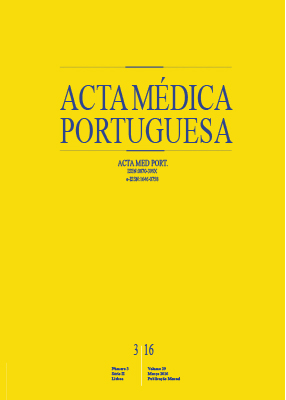Secondary Alveolar Bone Grafting in Orofacial Cleft: A Survey of a Portuguese Tertiary Hospital
DOI:
https://doi.org/10.20344/amp.6418Keywords:
Alveolar Bone Grafting, Cleft Lip, Cleft Palate, Reconstructive Surgical Procedures.Abstract
Introduction: Orofacial clefts are the most frequent craniofacial birth defects. In the presence of bone defect, the secondary alveolar bone grafting is the correction method most commonly accepted by clinicians. This study evaluates the result of this technique in a tertiary hospital.
Material and Methods: Analysis of the secondary alveolar bone grafting performed between 2007 and 2014, with inclusion of cases in which the iliac crest was the donor site for the graft and the clinical and imaging information was complete. The success of the intervention was assessed radiographically using the Bergland scale (type I-IV) and correlated to variables associated with pathology and/or surgical correction.
Results: Of the 32 secondary alveolar bone grafting performed, 29 met the inclusion criteria: 13 cases (44.8%) corresponded to complete unilateral pre-foramen clefts; four (13.8%) to complete bilateral pre-foramen clefts; eight (27.6%) to transforamen unilateral clefts and four (13.8%) to bilateral transforamen clefts. According to the scale of Bergland (applied with a mean follow-up of 8 ± 5 months) six were classified as type I, 15 as type II, five as type III and three as type IV. No association was found between the effectiveness of the surgery and the type of orofacial clefts, the presence of the incisor and the canine eruption phase. Five patients were re-operated (three of type II and two of type III at baseline).
Discussion: In this series, the secondary alveolar bone grafting was effective in most patients (72% type I & II) regardless of the type of orofacial clefts. The relatively high proportion of failures (10.3%) and subsequent need for re-intervention (17%) justify long-term follow up and the continuation of this study.
Conclusion: It is important to highlight the multidisciplinary involvement in order to identify previously the ideal timing for each intervention and to optimize results.
Downloads
Downloads
Published
How to Cite
Issue
Section
License
All the articles published in the AMP are open access and comply with the requirements of funding agencies or academic institutions. The AMP is governed by the terms of the Creative Commons ‘Attribution – Non-Commercial Use - (CC-BY-NC)’ license, regarding the use by third parties.
It is the author’s responsibility to obtain approval for the reproduction of figures, tables, etc. from other publications.
Upon acceptance of an article for publication, the authors will be asked to complete the ICMJE “Copyright Liability and Copyright Sharing Statement “(http://www.actamedicaportuguesa.com/info/AMP-NormasPublicacao.pdf) and the “Declaration of Potential Conflicts of Interest” (http:// www.icmje.org/conflicts-of-interest). An e-mail will be sent to the corresponding author to acknowledge receipt of the manuscript.
After publication, the authors are authorised to make their articles available in repositories of their institutions of origin, as long as they always mention where they were published and according to the Creative Commons license.









